Last Updated on January 20, 2024 by Greg Gillson
Did you see a brightly-colored red bird, orange bird, or yellow bird in Maryland and wonder what is was?
This page is for you!
This article shows you photos and identification of some of the most common birds in Maryland based on color.
The list of birds found in Maryland includes over 455 species. So, I can’t show you all of them. I’m going to assume that you saw a common bird of this color, but you certainly could have seen something less common, or even rare!
Shape (including the shape of the bill) and size are often more helpful in starting to identify a bird than the color. In fact, most birds in North American can be easily identified with a black-and-white photo!
Many birds are multi-colored, so that it may be hard to pick out a dominant color. Males and females may be colored quite differently. And some color patterns are similar among otherwise dissimilar species.
Nevertheless, I’m going to try to pick out some of the birds that you are most likely to see in backyards or towns. And I’ll show a few others that I get asked about a lot.
The birds with a noticeable amount of red on them in Maryland covered in this article are:
- Northern Cardinal
- American Robin
- House Finch
- Ruby-throated Hummingbird
- Scarlet Tanager
The birds with a noticeable amount of orange on them in Maryland covered in this article are:
- Eastern Towhee
- Barn Swallow
- Red-shouldered Hawk
- Brown Thrasher
- Wood Thrush
- American Redstart
- Cooper’s Hawk
- Baltimore Oriole
- Ruddy Duck
- Orchard Oriole
The birds with a noticeable amount of yellow on them, including lots of yellow and black birds, in Maryland covered in this article are:
- American Goldfinch
- Northern Flicker
- Common Yellowthroat
- Yellow-rumped Warbler
- Cedar Waxwing
- Great Crested Flycatcher
- Northern Parula
- Pine Warbler
- Yellow-breasted Chat
- Yellow Warbler
Red birds of Maryland
Birds get the red, orange, and yellow in their feathers from carotenoids in the fruit, seeds, and plants they eat (source).
These carotenoid colors combine with melanin to form an infinite range of red feathers–pink, rusty, scarlet, violet, red-orange.
The following are red birds that you are most likely to see in Maryland.
Northern Cardinal
These are one of the most common backyard birds in the eastern United States. Their bright red color and unique head profile makes them instantly identifiable to most people–whether they are bird watchers or not!
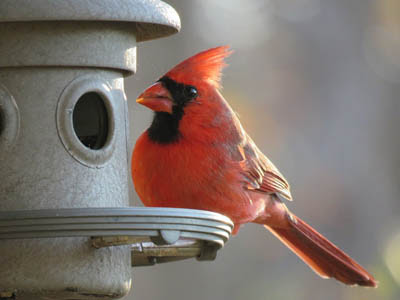 |
| Northern Cardinal. GeorgeB2 from Pixabay. |
Males of these large seed eaters are bright red with a black face and red crest.
Females replace most of the red with brown, The bill is large and orange.
These birds are found in woodlands, stream edges, residential areas.
Northern Cardinals are year-round residents throughout Maryland.
American Robin
These are familiar lawn birds with red breasts.
 |
| American Robin. Greg Gillson. |
Male American Robins are brownish-gray above with a brick red breast. Females are paler orange below and paler gray above.
They are widespread in open country with scattered deciduous trees, residential areas.
American Robins are year-round residents throughout Maryland.
House Finch
When people ask about a bird with a red head at their feeder, it is usually this bird.
 |
| Male House Finch. Greg Gillson. |
Males of this dusty brown striped finch have red limited to the head (specifically the forehead and eyebrow), breast (chest), and rump. The red coloration tends toward orangish, and may rarely be yellowish.
Females are streaked, similar to the males but without red. They lack any strong pattern on the face and head.
Note the small round head and curved upper ridge on the bill.
Some people call these red-headed sparrows. Sparrows and finches are similar, but in general, male finches are brighter than the females and tend to hang out more in trees. Sparrow genders are usually quite similar in coloration and tend to feed mostly on the ground.
These birds are common in residential areas, especially at bird feeders. In the West more widespread in arid regions near water.
House Finches are year-round residents throughout Maryland.
Ruby-throated Hummingbird
These red-throated birds are the only hummingbird nesting in the eastern United States.

Males are dark green above and on the belly. They have a white upper chest. The throat is ruby-red.
Females are green above, white below, including white throat.
These birds are found in woodland edges, residential yards. Readily come to hummingbird feeders.
Ruby-throated Hummingbirds are summer residents throughout Maryland.
Scarlet Tanager
A brilliant red and black bird!
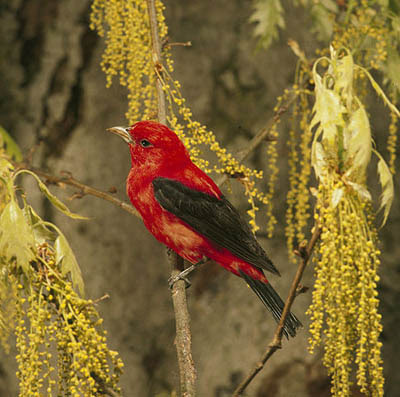 |
| Male Scarlet Tanager. USF&WS. Public Domain. |
Males are unmistakable with brilliant red with black wings and tail.
Females are olive-green above, darker wings and tail, yellower under parts. Pale bill.
These birds live in deciduous woods.
Scarlet Tanagers are summer residents throughout Maryland.
Orange birds of Maryland
True orange-colored birds are not that common. Many birds that I have here are paler rusty.
The common pattern is an orange body and black or brown wings and tail. Another common pattern is for the orange to be restricted to the under parts.
The following are orange birds that you are most likely to see in Maryland.
Eastern Towhee
These birds with rusty-orange sides like to hide in dense bushes.
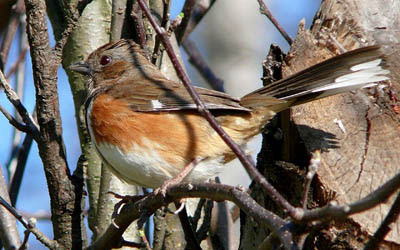 |
| Female Eastern Towhee. Skeeze. Pixabay. |
Males are black above with white wing patch, white tail corners. The sides are rusty. The belly white. Eyes variable: brown, red, orange, white, tending toward whiter southward.
Females are similar, but upper parts brown.
These birds are found in forest understory, dense brush, backyard hedges. Come to feeders.
Eastern Towhees are summer residents in northern and western Maryland, year-round residents in the southeastern Coastal Plain region.
Barn Swallow
These orange-bellied birds are a familiar sight across North America in summer.
 |
| Barn Swallow. Greg Gillson. |
These birds are purple-blue above with orange under parts and long forked tails. The color of the underparts in winter or on females are often cinnamon or buff-colored, but breeding males can be brighter orange-red.
These birds swoop low over fields and wetlands at lower elevations. They may build their mud nests in rafters on porches, garages, or other out-buildings.
Barn Swallows are summer residents throughout Maryland.
Red-shouldered Hawk
Okay, the shoulders are reddish. But the rusty-orange breast and wing linings are barred red too.
 |
| Red-shouldered Hawk. Greg Gillson. |
The upper parts are barred black and white. The tail is banded black and white. In adults the breast is barred orange.
Immature birds are streaked with brown on the breast.
These birds like woodland edges, residential edges, riparian groves.
Red-shouldered Hawks are year-round residents through most of Maryland, summer residents only in the mountains of far western Maryland.
Brown Thrasher
These are rather large rusty-orange songbirds.
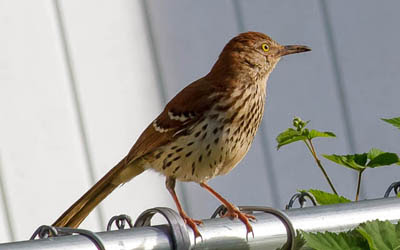 |
| Brown Thrasher. Linda Jones CC0. |
The upper parts of these birds is colored rusty-brown to orange. They show two white wing bars. Under parts are buff with heavy reddish-brown streaking.
These birds live in woodland edges and mature backyard landscaping.
Brown Thrashers are summer residents throughout most of Maryland, year-round residents in southeastern Coastal Plain.
Wood Thrush
These spotted birds with the orange-brown upper parts tend to hide in understory trees and on the forest floor.
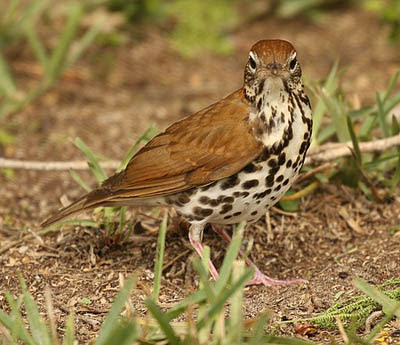 |
| Wood Thrush. Tony Castro. CC BY-SA 4.0 |
These birds are reddish brown on the upper parts, especially rusty orange on the crown and upper back. White eye ring. Large heavy black spots on the under parts.
They live in deciduous and mixed woods. Spend much time on the ground, shuffling through the leaf litter.
Wood Thrushes are summer residents throughout Maryland.
American Redstart
In flight these small warblers flash orange or yellow in the wing and base of the tail.
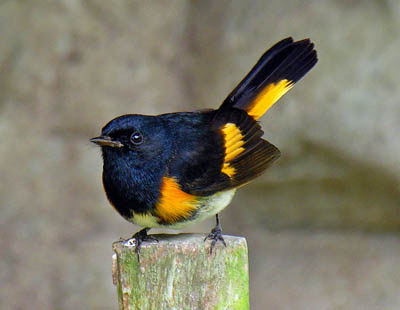 |
| American Redstart. Dennis Jarvis. Flikr. CC BY-SA 2.0 |
Males are black above, white on the belly. They have bright orange patches on side of breast, wings, and base of the tail.
Females are grayer, especially on the head. The orange of males is replaced by yellow on the females.
These birds are found in regenerating woods after a clear cut, and willow tangles along streams.
American Redstarts are summer residents throughout Maryland.
Cooper’s Hawk
These crow-sized hawks with reddish orange bars on the under parts may show up in fall or winter to hunt birds at your feeder. Oh no!
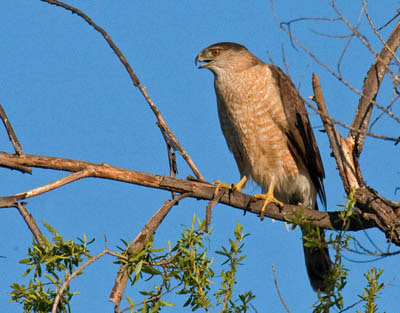 |
| Cooper’s Hawk. Greg Gillson. |
Adults with long gray and black banded tail. Dark gray above and cap on head. Under parts barred with rusty orange.
Immatures similar, brownish, streaked with brown on under parts.
Found in forests and woodlands, residential shade trees.
Cooper’s Hawks are year-round residents throughout Maryland.
Baltimore Oriole
These bright orange and black birds are fairly common breeders in wooded areas in the East.
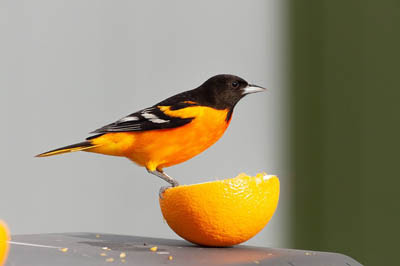 |
| Baltimore Oriole. Michael McGough. Pixabay. |
Males are have a black hood and back. Wings black with white patches. Tail black with orange sides to the base. Bright orange under parts.
Females are similar to males, but more olive above, less black. Immature birds for their first year or more are olive above orangish-yellow on the breast, fading to yellow on the belly. Two white wing bars.
These birds are common in deciduous woods, shade trees.
Baltimore Orioles are summer residents throughout Maryland.
Ruddy Duck
These small ducks are dark rusty-orange in spring.
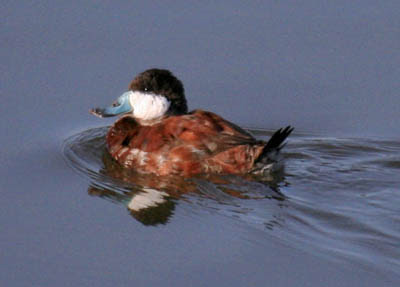 |
| Ruddy Duck. Greg Gillson. |
Males in breeding plumage (late winter and spring) are rusty, with a white face, and a blue bill. The long tail is often held sticking up. In winter they are brown, with white face, and dark bill.
Females all year are like winter males. Brown body, dark cap, dark line through eye of pale face. Dark bill.
These birds prefer weedy ponds to breed, but in winter may be found in deeper ponds in city parks.
Ruddy Ducks are winter visitors throughout Maryland.
Orchard Oriole
Males of these orioles are darker rustier-orange than most other orioles in the United States.
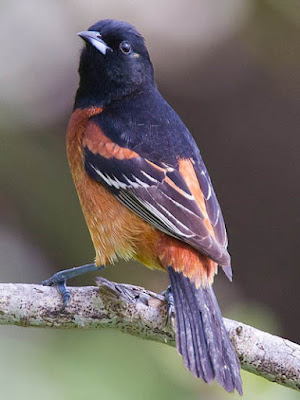 |
| Orchard Oriole. Dan Pancamo. Flikr. CC BY-SA 2.0 |
Males have a black hood and back, black wings and tail. The under parts are rusty-orange or even chestnut-brown.
Females are greenish above, lemon yellow below. They have 2 thin white wing bars. The bill is thinner than many other orioles.
They are found in orchards and residential shade trees.
Orchard Orioles are summer residents throughout Maryland.
Yellow birds of Maryland
Yellow is a common bird color! Often it is mixed with black and white plumage in birds.
Many birds with darker upper parts have yellow breast or belly.
The following are yellow birds you are most likely to see in Maryland.
American Goldfinch
These small little birds are bright yellow and black.
 |
| American Goldfinch. Greg Gillson. |
Males are bright lemon yellow with black and white wings and tail, black cap. White under tail coverts. Pink bill.
Females are duller yellow below and brownish above. Lack black cap.
Winter birds are pale brown or gray, a touch of yellow on the throat of males.
These are birds of open country, fields with saplings, clear cuts, residential areas. They avoid dense forests, mountains, deserts. They visit feeders.
American Goldfinches are year-round residents throughout Maryland.
Northern Flicker
These woodpeckers spend much time eating ants on the ground.
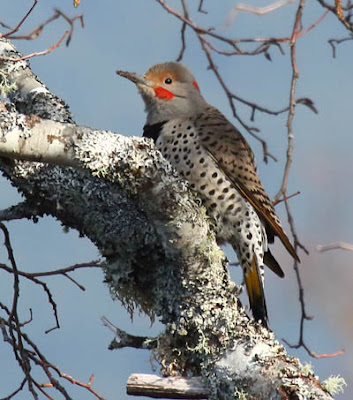 |
| Northern Flicker. Greg Gillson. |
These birds are larger than robins with brown and black barred upper parts. The underparts are pink with round black spots. There is a black crescent across the chest. When they fly away from you they reveal a large white rump.
Western birds have salmon-red under wings and under tail. Those in the East are colored yellow. The male face differs between the two populations–black whisker on the eastern birds, red whisker on western birds. Intergrades from overlap on Great Plains common. These may show male facial characteristics of both populations, or yellow-orange flight feathers.
These birds live in open woods with bare ground for foraging, residential yards.
Northern Flickers are year-round residents throughout Maryland.
Common Yellowthroat
These buttery yellow birds are abundant in the marsh vegetation.
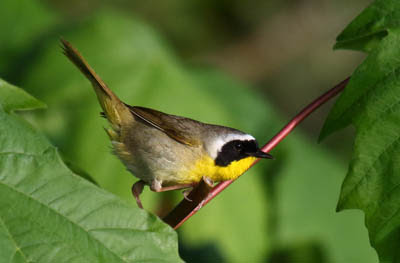 |
| Male Common Yellowthroat. Greg Gillson. |
These skulkers have bright yellow throats and yellow undertail coverts. Males have a black domino mask edged broadly in white, which females lack. Upperparts are dull olive-green.
Immature males in fall show a shadowed black mask.
Found in damp situations and heavy deciduous brambles following clear cuts.
Common Yellowthroats are summer residents throughout Maryland.
Yellow-rumped Warbler
These are abundant warblers across North America. Affectionately called “butter butts” by many birders, because of their bright yellow rumps that flash in flight.
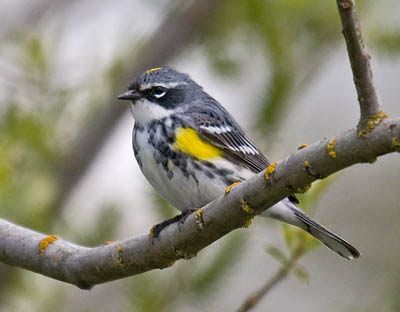 |
| Summer Yellow-rumped (Myrtle) Warbler. Greg Gillson. |
Western form (Audubon’s) with bright yellow throat and yellow rump. Large white wing patch.
Northern and Eastern form (Myrtle) with white throat, yellow rump, and two white wing bars.
Winter birds are dull gray brown, with bright yellow rump. Throat may be cream colored or white. Often difficult to tell the two forms apart in winter.
 |
| Winter Yellow-rumped Warbler. Greg Gillson. |
Breed in mountain or boreal conifers. Widespread in migration. Winter in low river bottoms, open weedy deciduous areas. Rarely come to feeders in winter.
Yellow-rumped Warblers are winter visitors throughout most of Maryland, spring and fall migrants and local summer residents in extreme western Maryland.
Cedar Waxwing
These crested birds with yellow band on the end of the tail are often found in flocks. They eat flying insects in summer, fruit and berries the rest of the year.
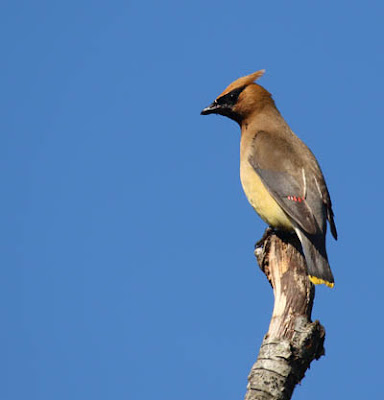 |
| Cedar Waxwing. Greg Gillson. |
These birds are fawn-brown above, with dark gray wings and tail. They have a black mask and wispy crest. The belly is yellow. The wings have waxy red drops on the end of the tertials. The end of the tail has a brilliant yellow tail band.
They are found in open habitats with berries, including juniper woodlands and towns in winter.
Cedar Waxwings are year-round residents throughout Maryland.
Great Crested Flycatcher
These flycatchers have long tails and big heads with big bill and bright yellow belly.
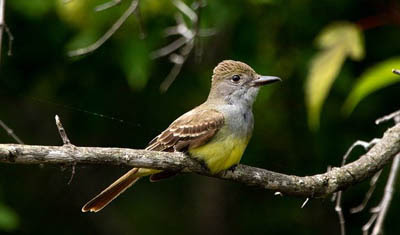 |
| Great Crested Flycatcher. Simard Francois. Pixabay. |
These birds are gray on the face and breast, brownish on rest of upper parts. Bright lemon yellow belly. The under side of the tail and some feathers of the wing are cinnamon colored.
These birds stay in the canopy of open woods.
Great Crested Flycatchers are summer residents throughout Maryland.
Northern Parula
This is a handsome blue and yellow warbler.

Males are blue on the hood and shoulders. Back green. Yellow throat and breast with a dark red spot mid-chest. Broken white eye ring. Two wide white wing bars.
Females are similar, but paler.
They are found along streams and in swampy forests with willows, maples, birches, hemlocks and other trees.
Northern Parulas are summer residents throughout Maryland.
Pine Warbler
This yellow and gray bird is one of the few warblers to visit feeders–and the only one to eat seeds!
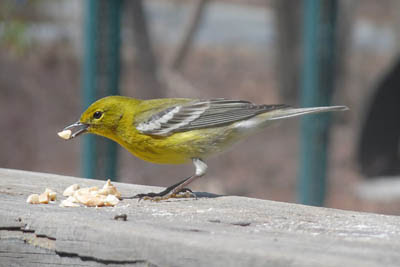 |
| Pine Warbler. Nikolaus Schultz. Pixabay. |
These birds are yellow-green on head, back, and breast. Wings blue-gray with wide white wing bars. Yellow split eye ring.
Strongly associated with pine forests. Usually high in tree tops.
Pine Warblers are summer residents throughout Maryland.
Yellow-breasted Chat
These unique larger yellow birds may sing day and night, and include whistles and crow-like cawing, often given in a display flight.
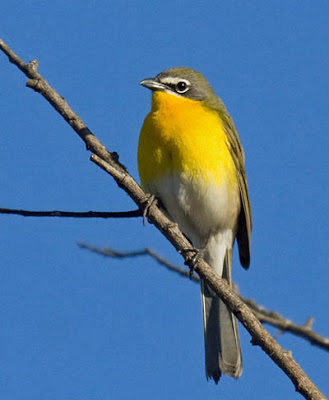 |
| Yellow-breasted Chat. Greg Gillson. |
These birds are greenish above with bright yellow breast and white belly. They have a dark mask bordered with white.
These birds live in tangles and wet woods.
Yellow-breasted Chats are summer residents throughout Maryland.
Yellow Warbler
The golden yellow sun packed all into one little bird! Appears to be an all-yellow bird.
 |
| Yellow Warbler. Greg Gillson. |
Some populations are bright yellow, some tend toward greenish on upper parts, some more golden. Yellow internal tail corners in flight.
Males with red breast streaking, again, variable by population.
Females somewhat to much paler yellow, some greenish, some whitish. Lack red streaks.
These birds are found in willow thickets on the edge of wetlands and ditches, stream sides in arid regions.
Yellow Warblers are summer residents throughout Maryland.
Wrapping Up
Maryland offers a diverse array of landscapes, from tidal marshes and coastal beaches to rolling hills and Appalachian forests, making it a haven for different bird species and a paradise for birders of all levels. Here are some fantastic places to explore for feathered encounters throughout the state:
Eastern Shore:
- Assateague Island National Seashore: Witness breathtaking coastal birds like ospreys, eagles, shorebirds, and waterfowl amidst stunning beaches and dunes.
- Blackwater National Wildlife Refuge: Embrace the beauty of wetlands, swamps, and tidal marshes, harboring bald eagles, herons, egrets, and migratory songbirds.
- Pocomoke River State Park: Discover diverse habitats like forests, marshes, and ponds, attracting warblers, sparrows, woodpeckers, and waterfowl.
Central Maryland:
- Patuxent Research Refuge: Explore a mix of forests, fields, and wetlands, offering opportunities to see eagles, owls, wood ducks, and migratory warblers.
- Catoctin Mountain Park: Hike amidst scenic forests and rocky outcrops, encountering woodpeckers, vireos, thrushes, and the occasional goshawk.
- Greenbelt Park: Find a haven for birders with various trails spanning forests, meadows, and ponds, attracting warblers, flycatchers, waterfowl, and raptors.
Western Maryland:
- Savage River State Forest: Embark on a journey through hemlock forests and rocky ravines, home to woodpeckers, owls, ravens, and even the elusive cerulean warbler.
- Garrett County: Explore the Appalachian foothills, teeming with diverse birdlife including ruffed grouse, wild turkeys, wood thrushes, and various warbler species.
- C&O Canal National Historical Park: Hike or bike along the scenic canal, encountering herons, kingfishers, ducks, and migratory songbirds along the Potomac River.
Frequently Asked Questions
What kind of bird is a small red head in Maryland?
Several small birds with red heads can be found in Maryland, so narrowing it down requires considering some additional details. Here are some possibilities:
- House Finch: Common year-round residents in Maryland, these small finches have reddish-brown heads and breasts with streaked backs. They frequent backyards, parks, and open woodlands.
- Northern Cardinal: While larger than a typical “small” bird, male Northern Cardinals have striking red plumage on their heads, chests, and beaks. They are common year-round residents in various habitats including backyards, forests, and shrublands.
- Scarlet Tanager: Males in breeding plumage (spring and summer) boast vibrant red bodies with black wings and tails, offering a splash of color in forests and woodlands. They prefer higher branches in dense foliage.
- Summer Tanager: Similar to the Scarlet Tanager, males have rose-red bodies and black wings, but are found in specific areas of Maryland with dense wooded habitats.
Where can I find the Baltimore Oriole in Maryland?
The Baltimore Oriole, Maryland’s state bird, is a vibrant sight and sound during spring and summer months. Thankfully, they’re relatively common throughout the state, so finding them isn’t too difficult if you know where to look:
Habitat:
- Open woodlands and forest edges: Orioles favor deciduous trees with plenty of space for flying and foraging. Look for them in parks, neighborhoods with mature trees, and along roadsides bordering woods.
- Orchards and fruit trees: They adore fruit, especially cherries, grapes, and oranges. Visiting orchards or backyards with fruit trees can increase your chances of spotting them.
- Wetlands and riparian areas: While not their prime habitat, they can sometimes be found near water sources, especially if fruit trees are present.
Timing:
- Spring and summer: Orioles arrive in Maryland around April and stay until August. This is the best time to see them in their colorful breeding plumage and hear their beautiful flute-like songs.
- Look for nests: Orioles build intricate, hanging nests, often in elm trees or other deciduous trees. Spotting a nest is a sure sign of their presence in the area.
What is the yellow bird that looks like a goldfinch?
When the American Goldfinch is not in breeding plumage, it looks a lot like some of the plainer warblers. Telling the difference between them can be tricky at first, but with some key points in mind, you can become a confident identifier! Here are some helpful tips:
Overall Look:
- Goldfinches: Chunky with short, conical bills, thick necks, and stubby tails. They often appear “bulky” compared to warblers.
- Warblers: Slender with thin, pointed bills, long necks, and long, often notched tails. They have a graceful, agile appearance.
Coloration:
- Goldfinches: Males in breeding plumage sport vibrant yellow bodies with black wings and white wing bars. Females and non-breeding males are more subdued olive-green with streaking.
- Warblers: Come in a much wider variety of colors, including yellows, greens, blues, reds, blacks, and oranges. Patterns can be intricate and vary greatly among species.
Related Articles:
See photos and learn about the most common backyard birds in Maryland, regardless of color.
See photos and learn what to feed winter birds in Maryland.
Here’s a quick tutorial of how I would teach you to identify birds: 7 Steps to Identify Birds!
Birds with red heads in North America.
Yellow-and-black birds in North America.










